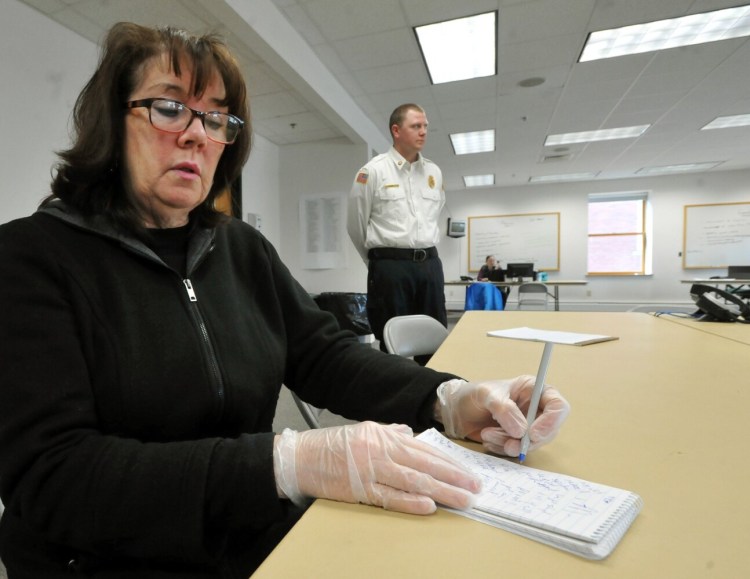It doesn’t seem possible when we wake up on a sunny spring morning that there’s a deadly virus out there, killing people.
But that’s the reality of the coronavirus.
The gravity of it hits home as we hear daily updates on the number of cases rising in Maine.
Like most everyone else, I’m frightened, not only for myself, but also for others.
Considered at-risk because I’m 60-plus and have an underlying condition, I am not disillusioned into thinking I might be spared just because I feel healthy and energetic.
We all know we could go to bed one night and wake up in the morning with the virus.
They say a little fear is good. It keeps us on our toes and taking precautions.
As a newspaper reporter, I must be out there getting the news, interviewing people, working to keep readers updated on what’s happening and providing helpful information, when possible.

Waterville Morning Sentinel reporter Amy Calder has her temperature rechecked Monday while exiting the new Emergency Operation Center at the Waterville Fire Department. Calder and another journalist had their temperature checked before being granted access to the building that houses the new Emergency Operations Center at the Waterville Fire Department. Calder was screened with another journalist before being allowed access to the building. Lt. Ryan Cote with the Waterville Fire Department takes Calder’s temperature. Morning Sentinel photo by Rich Abrahamson Buy this Photo
While we work from home now, most businesses are closed and fewer motorists are on the road getting into vehicle crashes, but other news doesn’t stop.
There are stories to be told about volunteers driving meals to shut-ins or sewing face masks, raising funds for struggling nonprofits and helping the elderly.
There are municipal, school board and other meetings to cover, albeit virtually, which can be tedious because of visual and audio issues as the bugs are worked out.
As news gatherers, we are recognized by the U.S. Department of Homeland Security as essential critical workers during this emergency, working as first informers connecting public health and government officials to the public. Thus, if streets are shut down or curfews imposed, we are authorized to travel in and around the state and afforded access to information.
Our jobs obligate us to leave the comfort of our homes when warranted.
That means visiting a coronavirus test site, covering a car accident, police standoff, robbery, fire or other incident.
As the coronavirus inches its way into our communities, there are days I ask myself if I’m crazy to take the risk.
But those thoughts are fleeting as I consider the alternative. I love what I do and feel a responsibility to readers to be the eyes and ears of those who can not be there.
On Monday, I visited Waterville’s Emergency Operations Center at the Fire Department where firefighters and police are on the front lines, responding to emergencies every day and exposing themselves to greater danger.
I was screened as I entered the station. A firefighter took my temperature and asked if I had any symptoms such as shortness of breath, cough, fever. When I said I did not, he asked if I had had contact with anyone experiencing those symptoms.
Had I replied yes to either, I would have been prohibited from entering the station.

Waterville Morning Sentinel reporter Amy Calder wears protective gloves as she reports on the coronavirus pandemic Monday at the new Emergency Operations Center at the Waterville Fire Department. Calder was screened with another journalist before being allowed access to the building. Morning Sentinel photo by Rich Abrahamson Buy this Photo
Police, fire and other officials working in the Emergency Operations Center are tested twice a day.
For me, being screened as such was a first in my more than 30 years as a reporter.
This is serious stuff.
As I left the fire station, a UPS driver was hauling in a dolly piled high with boxes of protective gloves.
The delivery consisted of 15 cases containing 2,000 gloves. In a normal situation, according to fire Chief Shawn Esler, that number of gloves would last about four months.
“This is more than what we usually get, but because of the COVID-19 situation, it could last only a few weeks,” he said.
Looking back at the station, I felt an immediate sense of deja vu.
The last time I was there for an event of such magnitude was Sept. 11, 2001.
I was reminded then that it’s always the first responders — police, fire and health care workers — who face the greatest risk, beyond that of the people they scramble to help.
With that thought, I counted my blessings.
After all, I’m merely here, tagging along to tell their stories.
Amy Calder has been a Morning Sentinel reporter 32 years. Her columns appear here Saturdays. She may be reached at acalder@centralmaine.com. For previous Reporting Aside columns, go to centralmaine.com.
Copy the Story LinkSend questions/comments to the editors.



Success. Please wait for the page to reload. If the page does not reload within 5 seconds, please refresh the page.
Enter your email and password to access comments.
Hi, to comment on stories you must . This profile is in addition to your subscription and website login.
Already have a commenting profile? .
Invalid username/password.
Please check your email to confirm and complete your registration.
Only subscribers are eligible to post comments. Please subscribe or login first for digital access. Here’s why.
Use the form below to reset your password. When you've submitted your account email, we will send an email with a reset code.